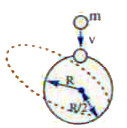Imagine a light planet is revolving round a very masstive star in a circular orbit of radius R with a time period of revolution T. If the gravitiational force of attraction between the star andplanets propostional to R−n, then T2 is propostional to Solution in Telugu
Rn+1
Rn+2
Rn−1
Rn−2
The correct Answer is:A
Step by step video, text & image solution for Imagine a light planet is revolving round a very masstive star in a circular orbit of radius R with a time period of revolution T. If the gravitiational force of attraction between the star andplanets propostional to R^(-n), then T^(2) is propostional to by Physics experts to help you in doubts & scoring excellent marks in Class 11 exams.
Updated on:21/07/2023Topper's Solved these Questions
- GRAVITATIONBook:AAKASH SERIESChapter:GRAVITATIONExercise:LECTURE SHEET (EXERCISE -I) Kepler.s Laws and Newton.s Law of Gravitation (Linked Comprehension Type Questions)
Explore 3 Videos
- GRAVITATIONBook:AAKASH SERIESChapter:GRAVITATIONExercise:LECTURE SHEET (EXERCISE -I) Kepler.s Laws and Newton.s Law of Gravitation (Matrix Matching Type Questions)
Explore 1 Video
- GRAVITATIONBook:AAKASH SERIESChapter:GRAVITATIONExercise:QUESTIONS FOR DESCRIPTIVE ANSWERS
Explore 2 Videos
- GAUSS.S LAW Book:AAKASH SERIESChapter:GAUSS.S LAW Exercise:PROBLEMS (LEVEL - II)
Explore 12 Videos
- GRAVITATIONALBook:AAKASH SERIESChapter:GRAVITATIONALExercise:EXERCISE -3
Explore 154 Videos
Similar Questions
A binary star system consists of two stars of masses m and 2 m. The separation between the centres is L. They revolve about the centre of mass of the system under their mutual gravitational interaction force.
Heavier star revolves in an orbit of radius
View SolutionMatch the following columns for a planet of mass m revolving around the sun is an elliptical oribt of semi-major axis a and semi-minor axis b. T is time period of planet.
Column-IColumn-II(A)T2∝a3(P) Kepler.s first law(B) Areal velocity is constant(Q) Kepler.s second law(C) Orbit of planet is elliptical(R) Kepler.s third law(D)2πmabT=constant(S)none of the above
View SolutionA wreckage of mass m present in space collides with a satellite of mass 10m and orbital radius R as shown. As a result of collision, the wreckage sticks to the satellite and the satellite is transferred to an orbit whose minimum distance from the planet is R/2. If mass of planet is M, with what velocity the wreckage collided the satellite?

View SolutionA charge q is placed at the centre of the open end of a cyclindrical vessel. Find the flux of the electric through the surface of the vessel.
View SolutionA satellite takes 1/8 years to move round the earth in its permissible orbit of radius R. The period when it revolves round the earth in an orbit of radius '2R' is
View SolutionImagine a light planet revoling around a very massiv star in a circular orbit of radius R with a period of revolution T. if the gravitatinal force of attraction between the planet and the star is proportional to R-(5//2)
View SolutionImagine a light planet revolving around a very massive star in a circular orbit of radius r with a period of revolution T. On what power of r will the square of time period will depend if the gravitational force of attraction between the planet and the star is proportional to r−5/2.
View SolutionA planet is revolving around a very massive star in a circular orbit of radius r with a period of revolution T. If the gravitational force of attraction between the planet and the star is proportional to r−n, then T2 is proportional to
View SolutionA light planet is revolving around a very massive star in a circular orbit of radius R with a period of revolution T, if the gravitational force of attraction between the two varies as R^(-5//2) , then T^(2) is proportional to :
View SolutionImagine a light planet revolving around a very massive star in a circular orbit of radius r with a period of revolution T.If the gravitational force of attraction between the planet and the star is proportional to r−3 ,then the square of the time period will be proportional to
View SolutionImagine a light planet revolving around a very massive star in a circular orbit of radius .r. with a period of revolution T. On what power of .r. will the square of time period depend on the gravitational force of attraction between the planet and the star is proportional to r^(-5//2)
View SolutionImagine a light planet is revolving round a very massive star in a circular orbit of radius R with a time period of revolution T. If the gravitational force of attraction between the star and planetis propostional to R^(-n) , then T^2 is propostional to
View SolutionImagine a light planet revolving around a very massive star in a circular orbit of radius 'r' with period of revolution T. On what power of 'r' will the square of time period depend on the gravitational force of attraction between the planet and the star is proportional to r−5/2
View SolutionImagine a light planet is revolving round a very massive star in a circular orbit of radius R with a time period of revolution T. If the gravitational force of attraction between the star and planetis propostional to R^(-n) , then T^(2) is propostional to
View SolutionImagine a light planet is revolving round a very massive star in a circular orbit of radius R with a time period of revolution T. If the gravitational force of attraction between the star and planet is proportional to R^(-n) , then T^2 is proportional to
View Solution